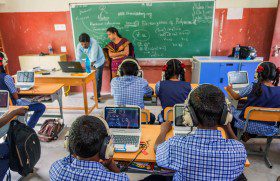This is the second blog post in a series from students enrolled in the course ‘Contemporary South Asia: Entrepreneurial Solutions to Intractable Social and Economic Problems’ taught by SAI Director Tarun Khanna. The course features several modules on issues facing South Asia: Urbanism, Technology and Education, Health, and Humanities.
This week’s focus: Technology and Education, with Tarun Khanna, Director of SAI, Jorge Paulo Lemann Professor, Harvard Business School
 By Siddarth Nagaraj, MALD Candidate, The Fletcher School of Law and Diplomacy,Tufts University
By Siddarth Nagaraj, MALD Candidate, The Fletcher School of Law and Diplomacy,Tufts University
Following our module on urbanism, we shifted toward closer scrutiny of social entrepreneurship and technology in South Asia. Our new module began this week with a lecture by Professor Khanna in which he challenged us to ponder the extent to which technological transmission of information can replace traditional means of teaching.

In the case of South Asia, the gap between the two often seems extreme. Whereas the educational videos of organizations such as Khan Academy and Udacity are viewed by hundreds of millions worldwide and have catalyzed a growing industry focused on remote learning, the subcontinent remains beset by formal education systems that serve their students appallingly.
During our brief reflection upon technology and education, we questioned whether those responsible for teaching future generations of South Asia can learn from the successes of these programs, or whether it is time for their responsibilities to be passed on fully to technologically based alternatives.
Partly due to the work of groups like Khan Academy and Udacity, technology is increasingly being regarded as both a means of learning information and a source of knowledge. Students and supporters praise such organizations for their reliability, the diversity and quality of courses offered and the ability of their lessons to be used according to individual learning preferences.
All of these are extremely valid arguments and having taught children in schools in the U.S. and India, I can personally attest to how the use of technology can positively transform how individuals react to and absorb information.
During the class, Professor Khanna cited a quotation by the late Sir Arthur C. Clarke, not only a legendary futurist but also a lover of South Asia: “Any teacher that can be replaced by a machine should be.”
The words received a somewhat mixed reaction from some of the students, including me. Professor Khanna posited that if a machine is capable of performing a teacher’s work more effectively, it makes sense to let it do that job with a more efficient result and re-allocate the teacher’s human capital elsewhere.
The economic logic behind that argument seems clear, but I wondered whether Clarke’s words also reflect a truth that education pioneers should remember, namely that an excellent teacher’s role in students’ lives is not merely didactic. The best teachers are those who not only convey information effectively and provide substantive professional training, but also inspire their students and provide mentorship at whatever level is possible.
That requires elements of human capital that cannot be fully transmitted through technological replacements. That particular dimension of teaching is far too frequently absent from South Asian schools, which need better inputs with regard to both technology and humans.
Technology has a significant role to play in improving South Asian education, but it is also critical to recognize its limitations. There are numerous teachers who can be replaced by a machine, but it is worth noting that many of them behave as if they are one when doing their job. Shrewd social entrepreneurs have recognized this fact, and the most successful innovations in the field of education technology will be those that continue to find ways to interact with numerous students while simultaneously connecting on an individual level.
Contemporary South Asia Student Blog: Understanding urbanism in megacities
